Collection of materials relating to neuro-ophthalmology as part of the Neuro-Ophthalmology Virtual Education Library.
NOVEL: https://novel.utah.edu/
TO
- NOVEL717
| Title | Creator | Description | Subject | ||
|---|---|---|---|---|---|
| 226 |
 |
Functional MRI | Devin D. Mackay, MD | Explanation of using functional MRI in examinations. | Functional MRI |
| 227 |
 |
Fundus Fluorescein Angiography: What Is It and When Is It Useful for Neuro-Ophthalmology? | Clare L. Fraser, MBBS; Elisa E. Cornish, PhD | An introduction to the use of fluorescein angiography. | Fluorescein Angiography; Visual Exam |
| 228 |
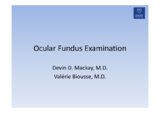 |
Fundus Photography | Devin D. Mackay, MD; Valérie Biousse, MD, | Explanation of using fundus photography in examinations. | Fundus Photography |
| 229 |
 |
Genetic Information Nondiscrimination Act of 2008 | Senate and House of Representatives of the United States of America in Congress | Law to prohibit discrimination on the basis of genetic information with respect to health insurance and employment. | Genetics |
| 230 |
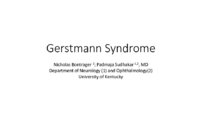 |
Gerstmann Syndrome | Nicholas Bontrager; Padmaja Sudhakar, MD | Gerstmann syndrome refers to a constellation of four neurologic deficits: agraphia, acalculia, finger agnosia , and left-right disorientation. All symptoms must be present for a diagnosis of true Gerstmann syndrome. | Gerstmann Syndrome |
| 231 |
 |
Giant Cell Arteritis | NANOS | Giant cell arteritis is a condition that can cause vision loss, new persistent headaches, scalp tenderness, and jaw pain with chewing. It is due to inflammation of blood vessels primarily of the head and neck. | Giant Cell Arteritis; Patient Brochure |
| 232 |
 |
Giant Cell Arteritis with Choroidal Infarction | Aretha Zhu; Kareem Moussa; Tina Zeng; Yin Allison Liu | The presentation describing a case of giant cell arteritis (GCA) with choroidal infarction documents an 83-year-old male experiencing recurring episodes of vision loss, predominantly manifesting as a "graying" of vision in both eyes, associated with new-onset headaches. The individual presented to t... | Choroidal Infarction; Erythrocyte Sedimentation Rate, Giant Cell Arteritis; Headache; Jaw Claudication; Painless Vision Loss; Rheumatology; Temporal Artery Biopsy; Vasculitis |
| 233 |
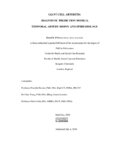 |
Giant Cell Arteritis: Diagnostic Prediction Models, Temporal Artery Biopsy and Epidemiology | Edsel Ing MD, PhD FRCSC MPH CPH MIAD MEd MBA, | Giant cell arteritis (GCA) is the most common primary vasculitis in the elderly and can cause irreversible blindness, aortitis, and stroke. Diagnostic confirmation of GCA usually entails temporal artery biopsy (TABx) - a time-consuming and invasive test, or ultrasound. The primary treatment of GCA i... | Giant Cell Arteritis; Diagnostic Prediction Model; Epidemiology; Temporal Artery Biopsy; Differential Diagnosis |
| 234 |
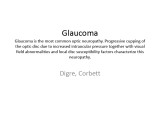 |
Glaucoma | Kathleen B. Digre, MD; James J. Corbett, MD | Slideshow describing condition. | Glaucoma |
| 235 |
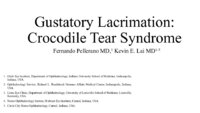 |
Gustatory Lacrimation: Crocodile Tear Syndrome | Fernando Pellerano; Kevin Lai | We describe a case of gustatory lacrimation on a 61-year-old male with a history of Bell's Palsy that presented to the Ophthalmology clinic with painless epiphora in the right eye while eating. Examination was notable for oral-ocular synkinesis and hyperlacrimation while eating on the right eye only... | Crocodile Tear Syndrome; Gustatory Lacrimation; Oral-ocular Synkinesis |
| 236 |
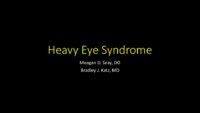 |
Heavy Eye Syndrome | Meagan D. Seay, DO; Bradley J. Katz, MD | A brief overview of heavy eye syndrome. | Heavy Eye Syndrome |
| 237 |
 |
Hemifacial Spasme - Hemifacial Spasm (Danish) | NANOS | Involuntary contractions, called "spasms," of the muscles on one side of the face. The affected side of the face seems to "scrunch up" while the other side of the face remains normal. | Hemifacial Spasm; Patient Brochure |
| 238 |
 |
Hemifacial Spasm | Shirley H. Wray, MD, PhD, FRCP | The patient is a 72 year old man with myopia, childhood exotropia, progressive age related ptosis and right hemifacial spasm. Hemifacial spasm (HS) most often begins insidiously in the orbicularis oculi muscle in the early stages, as in this man. He presented with a 2 year history of involuntary twi... | Lid Twitch; Hemifacial Spasm; Neurovascular Compression Syndrome of the Facial Nerve |
| 239 |
 |
Hemifacial Spasm | NANOS | Involuntary contractions, called "spasms," of the muscles on one side of the face. The affected side of the face seems to "scrunch up" while the other side of the face remains normal. | Hemifacial Spasm; Patient Brochure |
| 240 |
 |
Hemifacial Spasm (French) | NANOS | Involuntary contractions, called "spasms," of the muscles on one side of the face. The affected side of the face seems to "scrunch up" while the other side of the face remains normal. | Hemifacial Spasm; Patient Brochure |
| 241 |
 |
Hemifacial Spasm (German) | NANOS | Involuntary contractions, called "spasms," of the muscles on one side of the face. The affected side of the face seems to "scrunch up" while the other side of the face remains normal. | Hemifacial Spasm; Patient Brochure |
| 242 |
 |
Hemifacial Spasm (Hebrew) | NANOS | Involuntary contractions, called "spasms," of the muscles on one side of the face. The affected side of the face seems to "scrunch up" while the other side of the face remains normal. | Hemifacial Spasm; Patient Brochure |
| 243 |
 |
Hemifacial Spasm (Hungarian) | NANOS | Involuntary contractions, called "spasms," of the muscles on one side of the face. The affected side of the face seems to "scrunch up" while the other side of the face remains normal. | Hemifacial Spasm; Patient Brochure |
| 244 |
 |
Hemifacial Spasm (Italian) | North American Neuro-Ophthalmology Society | Involuntary contractions, called "spasms," of the muscles on one side of the face. The affected side of the face seems to "scrunch up" while the other side of the face remains normal. | Hemifacial Spasm; Patient Brochure |
| 245 |
 |
Hemifacial Spasm (Japanese) | NANOS | Involuntary contractions, called "spasms," of the muscles on one side of the face. The affected side of the face seems to "scrunch up" while the other side of the face remains normal. | Hemifacial Spasm; Patient Brochure |
| 246 |
 |
Hemifacial Spasm (Korean) | NANOS | Involuntary contractions, called "spasms," of the muscles on one side of the face. The affected side of the face seems to "scrunch up" while the other side of the face remains normal. | Hemifacial Spasm; Patient Brochure |
| 247 |
 |
Hemifacial Spasm (Portuguese) | NANOS | Involuntary contractions, called "spasms," of the muscles on one side of the face. The affected side of the face seems to "scrunch up" while the other side of the face remains normal. | Hemifacial Spasm; Patient Brochure |
| 248 |
 |
Hemifacial Spasm (Simplified Chinese) | NANOS | Involuntary contractions, called "spasms," of the muscles on one side of the face. The affected side of the face seems to "scrunch up" while the other side of the face remains normal. | Hemifacial Spasm; Patient Brochure |
| 249 |
 |
Hemifacial Spasm (Spanish) | NANOS | Involuntary contractions, called "spasms," of the muscles on one side of the face. The affected side of the face seems to "scrunch up" while the other side of the face remains normal. | Hemifacial Spasm; Patient Brochure |
| 250 |
 |
Hemifacial Spasm (Tagalog) | NANOS | Involuntary contractions, called "spasms," of the muscles on one side of the face. The affected side of the face seems to "scrunch up" while the other side of the face remains normal. | Hemifacial Spasm; Patient Brochure |
